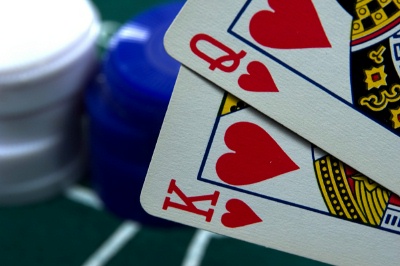|
|

Flush Draw – A drawing hand which contains four of the five cards necessary to complete a flush.
In most poker games, a valid poker hand must contain five cards. A flush consists of five cards of the same suit. If a player has only
four cards of a particular suit, it adds no value to
their hand at showdown. They must catch a fifth suited card in order to complete their flush. When a player holds four cards to a flush,
and there are still cards left to come, he holds a flush draw. If the final card comes and he does not complete his flush, he now holds
a busted flush draw.
The most powerful hand you can make in most poker games is a
straight flush. This consists of five
suited cards which are also in perfect sequence, for instance Q♠ J ♠ T ♠ 9 ♠ 8 ♠. A player who holds four
of the five cards necessary to complete a straight flush holds a straight flush draw. When a straight flush is not possible, an ace high
flush draw is the best possible flush draw. Depending upon the type of poker game you are in, you may hear an ace high flush draw referred
to as a nut flush draw. A flush draw consisting of four low ranking cards is sometimes called a baby flush draw.
A flush draw can be a very powerful draw in a variety of different poker games, including Hold’em, Stud, and Omaha. If you complete
one, a flush can be a very strong hand. The only hands that beat it are a higher flush, a full house, four of a kind, or a straight
flush. However, if you fail to complete your flush, you are often left with a very weak hand. Since suited cards are necessarily
unpaired, when you hold four of them and miss your flush, you may have only high cards to play.
This leads to a sense of anticipation when a player is on a flush draw. The situation is often clear. If you complete your flush draw
you will likely win the pot. If you fail to complete it, you usually will not win the pot. That does not necessarily mean you should give
up just because you have missed your flush draw. Depending upon the situation, if you have been betting your draw the whole way, it sometimes
makes since to fire one more bet at the pot on the river,
to try to take it down by bluffing. You don’t have to be successful very often for this play to be profitable.
Remember, the decision to bluff in this spot is made after all of the money is already in the pot. This decision should be made based
upon a proper analysis of pot odds, implied odds, or preferably, both. If you divide the amount of the pot by your river bet, you can
find out how often you need to successfully pull off the bluff in order to make it a profitable play. For example, if there were $60
in the pot, and it cost you $6 to try to bluff on the river, you would have to win, on average, at least one pot out of ten to make
bluffing profitable over the long run. Here is why. If you consider that it costs $6 to try to bluff, you can also say that it costs
$60 to try to bluff ten times. If you are successful on one of those occasions, you will receive the $60 that was in the pot, plus
your $6 river bet. This represents a $66 return for your $60 investment. Given these inputs, the bluff play is clearly profitable and
worth making. Anything better than a ten percent long term success rate increases the play’s profitability. Anything less than a ten
percent success rate makes the bluff play unprofitable and not worth making. As you can see, you should sometimes bluff when you hold
a busted flush draw, even if you don’t think that you are very likely to get away with it. It can also benefit you to show a bluff
from time to time. If your opponents know that you are capable of it, it will force them to pay you off with a wider variety of hands.
In other words, getting caught bluffing gets you paid off when you do actually have a hand.
Usage: Nut Flush Draw, Runner Runner Flush Draw, Baby Flush Draw
Previous Poker Term: Flush
Next Poker Term: Fold Equity |
|









